And both herds nicely hung out within zoom range.
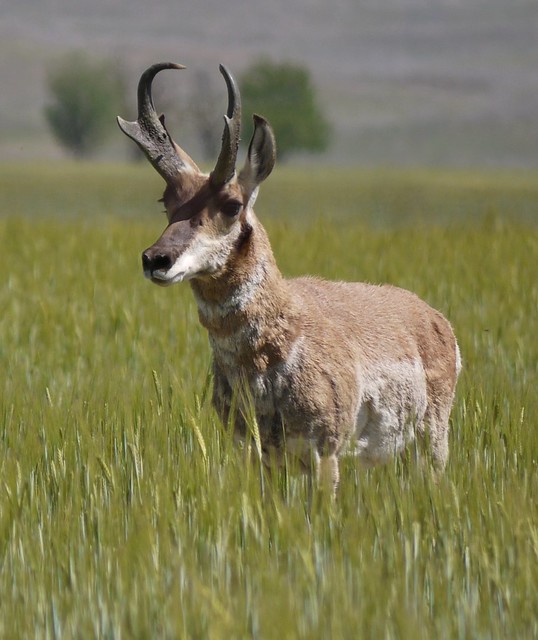
Male pronghorn, Antilocapra americana, on the Carrizo Plain. Like cattle and bighorn sheep, pronghorn have permanent horns, not seasonally-shed bony antlers. And, also like bighorn and many cattle, the females have them too
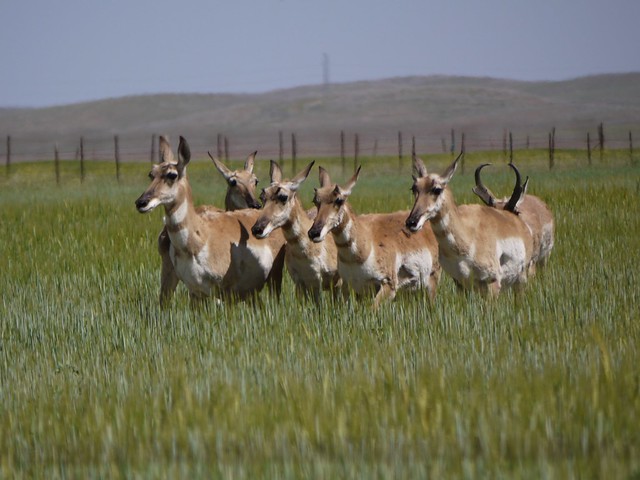
Male moving his "harem" of 5 ladies
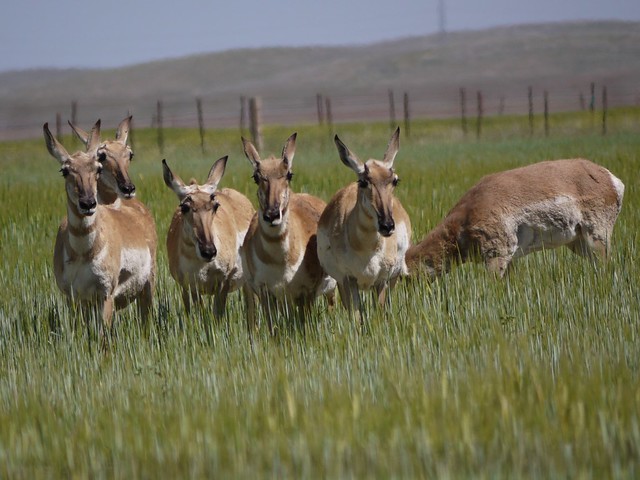
To keep them where he wants to forage
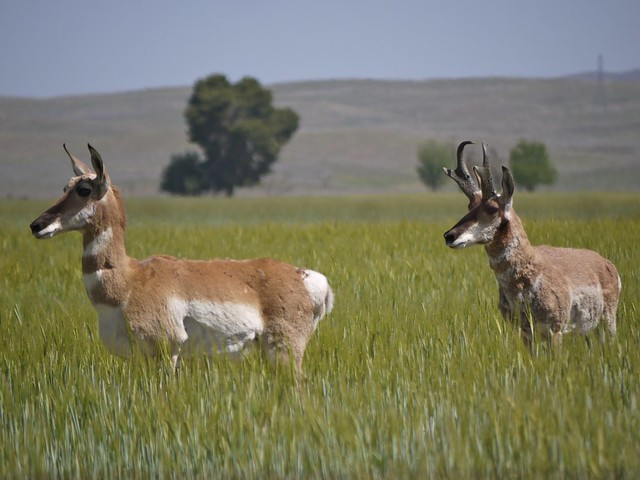
Female and male watching us watch them - "see - if we just stand around and look cute, they keep planting all this tasty barley"
Pronghorn and bighorn used to be our only remaining native Bovines in CA. But even though they have 4-compartment stomachs, cloven hooves, and horns, biologists re-classified the pronghorn, deciding that it was a bit too different to be a true bovine. Their branching and sheath-shedding horns, for example, are unique to the species - no other bovine has those features. So now each are the last of their California kind.
But the question I hear most about pronghorn is: "are they antelope?"
The answer is not really. That's just a name given to them because they look like African antelope, and fulfill a similar niche (good old convergent evolution in action). While they are in the same Order as antelope and gazelles, Artiodactyla (even-toed hoofed animals), that high-level grouping also includes deer, cattle, pigs, sheep, camels, hippos and giraffes. So, saying they're "antelope" is the equivalent to saying they're moose, or giraffes. In fact, African giraffes appear to be the nearest genetic relative to pronghorn, which is the only living member of the 12 species of Antilocapridae (antelope-like) that have roamed North America in the last million years.
The re-introduced population on the Carrizo Plain certainly isn't doing great. With less than 100 total individuals, their numbers are stagnant at best, and they often lose ground in tough years. Fragmenting of native grazing lands seems to be the top inhibitor. And domestic animal-borne diseases. Evolved roaming the large arid ranges of the west to find the shrubs & forage they need, developments and fences (they're notoriously poor jumpers) are boxing them into areas too small to sustain growth. Except in eastern CA, where the land is still big - there's thousands. Of course, the fact we ate the other 490,000 that lived in pre-1800 CA has to be the biggest limiter.
Some bighorn sheep populations in the expanses on the east side of CA are doing ok too, such as the Desert Bighorn of the Mojave area, Ovis canadensis nelsoni. The numbers of this subspecies are up to around 4,000 individuals in southern CA. Unfortunately, their cousins, the Sierra Bighorn, Ovis canadensis sierrae, aren't faring as well. Hence the collaring of kitties to help protect them.
We happened on ~ 20 Desert Bighorn while visiting the infamous Zzyzx. Evidently, the bighorn like to come down to the area for water in drought years. I guess for them, Lake Tuendae and the soda springs existed long before the spa town was built on top of it. Dang inconvenient humans.

Ewe and lamb Desert Bighorn Sheep, Ovis canadensis nelsoni, near Zzyzx
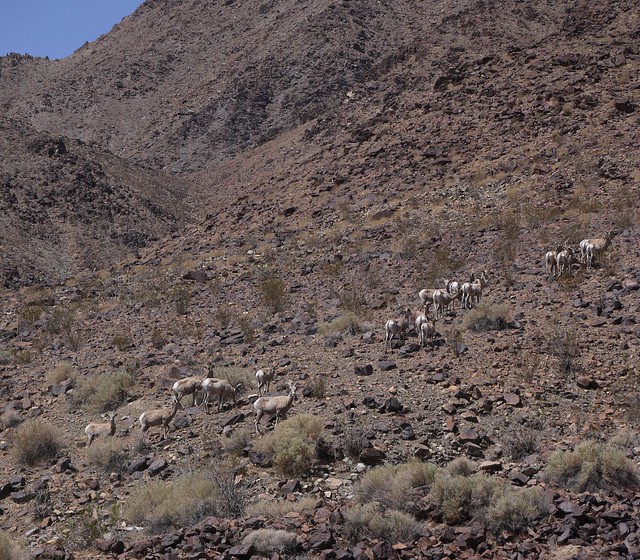
The herd - all ewes and young. Like many hoofed animals, the males generally hang out separate or in small groups when it's not mating season
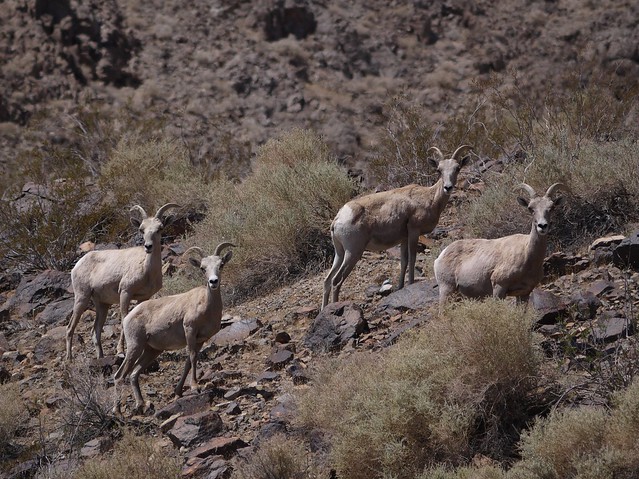
Bighorn, like pronghorn, are versatile vegetarians, and can both graze and browse - eating grasses, forbs, cacti, and even the leaves of tough perennial trees and shrubs, such as the creosote and salt bush around these four ewes

Ladies giving us one last look as we left
Pronghorn and Bighorn. Always a treat to see.
====
References:
- Camera Trapping Campus - Desert Freaks
- Wikipedia - Pronghorn
- Wikipedia - Desert Bighorn Sheep
- Wikipedia - Artiodactyla
- Wikipedia - Antilocapridae

Great post! Very informative, paired with lovely images. Nice job :).
ReplyDeleteThat first picture of the pronghorn is amazing!
ReplyDeleteAll great photos...but as jason said...that first pronghorn shot is particularly nice.
ReplyDeleteThe "Prairie Ghost"!
Interesting about the behavioral differences between the newly reclassified pronghorn and the bighorn. Male pronghorns seem to like hanging with their females, and the male bighorns hang out separately until need arises. Do you think the female bighorns talk too much for the males to deal? I'm off to look up giraffes...
ReplyDeleteWOW - thank you for great photos! - I had a wonderful time at the Carrizo Plain some years ago but only ever caught a distant glimpse of running pronghorn.
ReplyDelete1. GREAT pairing in your post title. =) As a bio-dork and word-nerd, it brought me delight.
ReplyDelete2. SO interesting, and stuff dear to my heart. Have you read Why We Run by Bernd Heinrich (http://books.google.com/books/about/Why_We_Run.html?id=UEw4eN-5kgsC)? It talks about humans as runners and he looks long and hard at the AMAZING ENDURANCE MACHINES that are pronghorn. =) Super interesting, highly recommend.
3. Haven't heard Zzyzx in a long time-wore out my Desert Studies Center t-shirt, and lost my (beloved) Zzyzx mug. Apparently I need to go again.
4. A genetic study of pronghorns on either side of a (fenced) railroad track by Charles van Riper III (https://profile.usgs.gov/charles_van_riper) showed there was virtually NO genetic mixing between the two populations. Totally separated the populations. Not a happy thing, but SO important to understand.
Thanks for the great post!!
Hot damn that 400mm lens treats you well.
ReplyDeleteI still haven't seen the pronghorn in the Carrizo or Chalome Valley, only Wyoming and Modoc Plateau (CA by a few miles). Maybe next time.
Wasn't nice of them all to pose in good light? Always love it when that happens.
ReplyDeleteKatie - the male pronghorn may be with his harem because they're in breeding season, whereas the bighorn may have a diff season. (at least I think)
BB - thanks for the great references - I'll check em out. Yes, they seem to only cross fences if they can go under them. They absolutely do not like to jump. Bit surprising for a hoofer that can hit 45mph, but they got no hops.
JK - lemme know the next time you head through the Carrizo - I know a few spots where they like to hang because the farmers plant tasties.